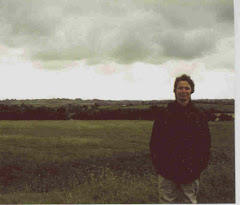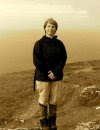
This weekend we went to north Yorkshire to do the Bronte pilgrimage. I had last been there in 2006, and in three short years, the winds of change have sprinted through the countryside, like the sprouting wind farms on the ridges. Blake’s “dark satanic mills” are now “dark satanic condos” called things like Bronte Square or Moorside Flats. On walking down the main road into Haworth, one passes an old mill set prominently in the hill side. Behind, the mill, crawling like a fungus, are housing developments, but none have reached the heights yet. Where do these people work, I wonder? Not in Haworth, that’s for sure. Perhaps they live in the grey, blocky Town nearby called Keighly. It would be a 15 minute commute on sweet twisty road, so I suppose Haworth and the little towns around like Stanbury, Oxenhope, and Hebden Bridge are bed-room communities for Keighly. Nevertheless, given the settlement patterns, as soon as you are out from the influence of the housing developments in the dales, and start to stretch into the further dales, there are still sheep farms with untidy working yards and enthusiastic dogs.
Haworth itself banks a lot on the steep 19th century main street which is lined with shops and pubs. The shops are much swanker now, with up to date fashions and hair stylists who advertise moussey young men pouting on the window posters. The weekend we were there, Haworth was having 60’s weekend. All the people who remembered the 60’s (do the math) were dressed up in flowered bell bottoms, polyester wigs, and short plastic mini-dresses (did you do the math for the full visual of the plastic mini-dresses?) I almost expired from the juxtaposition of conflicting genres. There was a band hired to play 60’s tunes, but they got tired of that part way through my walk down the main street and unaccountably finished “I only want to be with you ” to WWII German oompah tunes. What?!
In my personal Byronic quest for the sublime, which I often inflict on my travelling companions, I felt that Emily and Charlotte Bronte could not be fully comprehended without the experience of walking in the moors.

Therefore, in the patchy rain and blowing wind, the ladies and I hiked off over Penistone Country Park, around Round Hill, and up across Haworth Moor to Top Withins. The wind blew, the rain was patchy, the sky was billowing grey clouds, and it was cold. It was wonderful!

Perfectly sublime. Looking back, one could see the gentle dales with their manicured lawns, but here on the heights it was all bracken and heather. And poop. I did forget to tell my companions about the poop. I had warned everyone to bring raincoats and sturdy walking shoes, but I neglected to mention that all hill walking involves navigating a panoply of poop. Sheep poop (liberally distributed), rabbit poop (less intrusive), and horse poop (always right on the path). Poor Thelma mourned the fact that she needed to keep looking down so as to avoid the poop such that she could not look up and enjoy the moor. Note to self: mention poop issues next time.
When we reached the Bronte Falls, time was waning.

I suggested we forgo the final mile to Top Withins, but this set up a howl of protest. “No, no, we can’t come this far and not get to Wuthering Heights!” And so we set off at a swifter pace up the last mile to Top Withins. Despite the blustery weather, it was so populated at the top that it was hard to find a seat for a proper snack. There was a also a particularly aggressive ewe who demanded lunch-tribute from every human at Top Withins. It was just a sheep, people! However, she did manage to intimidate (!) several people into giving her their lunch. She tried to get lunch from one of my companions, but I (gently) kicked her so she lost interest.

We flew back down the hill and off the moor, through town via the bakery, and everybody got on a bus to send them off to Edinburgh in a whirlwind of travel favoured by the young. Damage: fourteen wet muddy feet, five blisters, one swollen knee, one "slightly" twisted ankle.
I really think that to understand these two novels, it is important to get the feel for the Town vs. Moor dichotomy.

The close cobbled street is in stark contrast to the open moors. At the time of the novels the parsonage was right on the moor. The next day I attended the service at the church where Patrick Bronte (nee Padraig Brunty) preached. It was dark and cold. I walked out into the sunshine and openness of the walk up the hills and over the moor to Ponden Hall. The contrast was striking: the limits of the house vs. the freedom of nature. Also, Ponden Hall is quite humble, really.

Its grandness is quite exaggerated in the movies. It is also an easy walk from Haworth to Stanbury, so it was no trial to go there for books, as the sisters are said to have done.
I think this time around, I have a greater sympathy for Emily in her reserve and her love of dogs and walking. As I crossed the moor early Sunday morning, it was clear that 150 years later, it is still local tradition to walk with your dog out on the moor. I can more clearly see so much of Heathcliff and Cathy both in that one person. When I read it again, I will try to think about how Isabella and Linton Heathcliff fit in.
However, I MUST mention my Byronic moment of heroism. I was walking back from Ponden Hall on the Penine Way, and I saw that one of the local Highland cows with big pointy horns had gotten loose and was standing indecisively in the road.

Big. Black. Pointy Horns. Very Shaggy. Think Hound of Baskervilles with horns. No big deal, I thought, its just a cow. So I raised my arms to look big and used my "voice of command" (that I use on misbehaving dogs), and I said, "Get on, get on", and the cow turned around and trotted off down the road. Yay, I thought, problem solved. When I came to the place where I had to turn up the hill, there was Hairy Black Cow with Big Pointy Horns. Drat, I thought, raised my arms, and said, "Get on, get on with you." Alas, HBC with BPH turned up the Penine Way, and with nothing else to do, I followed the deep hoof prints up the track. This made sense since I knew his pasture was in this direction. He was just going home. As I rounded the turn in the walled lane towards HBC with BPH's pasture, I saw a large group of walkers coming down the lane in the opposite direction. HBC was caught in the classic pincers movement Napolean used to defeat so many enemies. He stood indecisively again and pranced a bit. Now, I have read the Worst Case Scenario Handbook, and I tried to recall the advice it gave about how to fight a bull. I think it said to wait until the last minute as it charges you, and only then turn because cows cannot pivot on their front feet (but buffalo can). This was my plan B. Plan A was to raise my arms and calmly tell BHC to "Get on" since it had worked before. Luckily, this convinced the confused bovine to jump back into his pasture and then bellow his displeasure. The walkers who had witnessed this "drama" came out of their terrified huddle and told me I "had the Right Stuff" and thanked me for saving them from the Wild Bull. Of course I refrained from telling them about my Plan B since they liked the results of Plan A so well. I just gave them the "Yorkshire Nod" said, "Right enough." I spent the next 10 minutes of my walk feeling awfully rugged.
 We are off to the Big City now. After our Country residence, we are off for our London Season. Big city living will be pretty interesting after our leisurly life here at the manor where other people make our food, and there are plenty of quiet, private spaces to sit. We are staying in the utter central area of the city across from St. Paul's Cathedral.
We are off to the Big City now. After our Country residence, we are off for our London Season. Big city living will be pretty interesting after our leisurly life here at the manor where other people make our food, and there are plenty of quiet, private spaces to sit. We are staying in the utter central area of the city across from St. Paul's Cathedral.  Luckily, we are in walking distance of the Blackfriar's Pub, the Globe, and the Tate Modern. These are Good Things. But where will I do my yoga in the morning? I may have to forgo the two mile walk and 1/2 hour of yoga each morning in this urban setting. And this also means no internet access. It is a little odd that going totally urban for us means a big jump down in technology. I have my mobile phone, but who am I gonna call (except for the proverbial ghostbusters)?
Luckily, we are in walking distance of the Blackfriar's Pub, the Globe, and the Tate Modern. These are Good Things. But where will I do my yoga in the morning? I may have to forgo the two mile walk and 1/2 hour of yoga each morning in this urban setting. And this also means no internet access. It is a little odd that going totally urban for us means a big jump down in technology. I have my mobile phone, but who am I gonna call (except for the proverbial ghostbusters)?  After our discussions of romanticism and the gothic, I think it is fitting that suddenly we are dispossed of our 19th century country lifestyle here at the manor and, will we or nill we, thrust into the hectic pace of modern life. I hope my companions can feel this as a fun intellectual exercise rather than a brutal shock. I suppose it all depends on how grotty the hostel is...
After our discussions of romanticism and the gothic, I think it is fitting that suddenly we are dispossed of our 19th century country lifestyle here at the manor and, will we or nill we, thrust into the hectic pace of modern life. I hope my companions can feel this as a fun intellectual exercise rather than a brutal shock. I suppose it all depends on how grotty the hostel is...











































